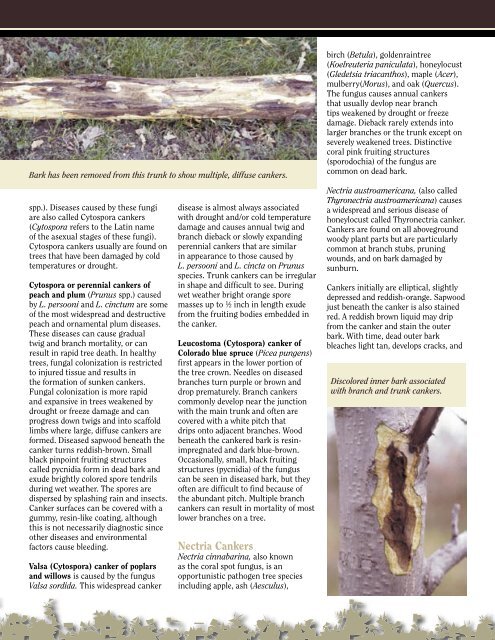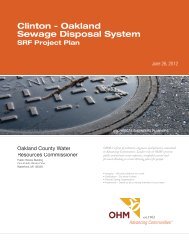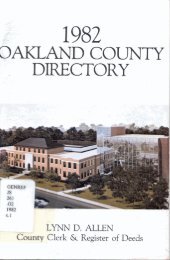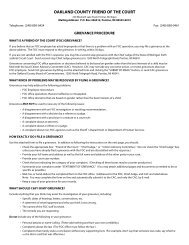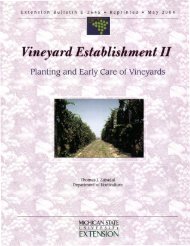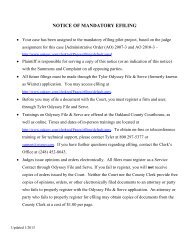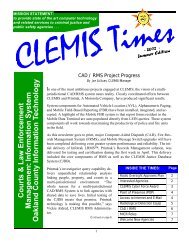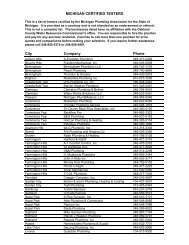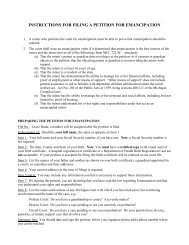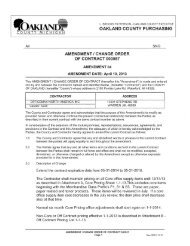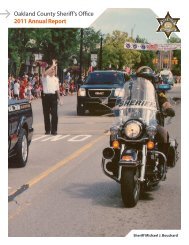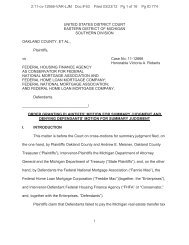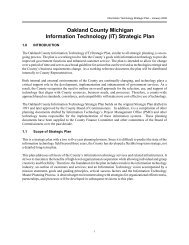MF2658 Canker Diseases of Trees - Kansas State University
MF2658 Canker Diseases of Trees - Kansas State University
MF2658 Canker Diseases of Trees - Kansas State University
Create successful ePaper yourself
Turn your PDF publications into a flip-book with our unique Google optimized e-Paper software.
Bark has been removed from this trunk to show multiple, diffuse cankers.<br />
spp.). <strong>Diseases</strong> caused by these fungi<br />
are also called Cytospora cankers<br />
(Cytospora refers to the Latin name<br />
<strong>of</strong> the asexual stages <strong>of</strong> these fungi).<br />
Cytospora cankers usually are found on<br />
trees that have been damaged by cold<br />
temperatures or drought.<br />
Cytospora or perennial cankers <strong>of</strong><br />
peach and plum (Prunus spp.) caused<br />
by L. persooni and L. cinctum are some<br />
<strong>of</strong> the most widespread and destructive<br />
peach and ornamental plum diseases.<br />
These diseases can cause gradual<br />
twig and branch mortality, or can<br />
result in rapid tree death. In healthy<br />
trees, fungal colonization is restricted<br />
to injured tissue and results in<br />
the formation <strong>of</strong> sunken cankers.<br />
Fungal colonization is more rapid<br />
and expansive in trees weakened by<br />
drought or freeze damage and can<br />
progress down twigs and into scaffold<br />
limbs where large, diffuse cankers are<br />
formed. Diseased sapwood beneath the<br />
canker turns reddish-brown. Small<br />
black pinpoint fruiting structures<br />
called pycnidia form in dead bark and<br />
exude brightly colored spore tendrils<br />
during wet weather. The spores are<br />
dispersed by splashing rain and insects.<br />
<strong>Canker</strong> surfaces can be covered with a<br />
gummy, resin-like coating, although<br />
this is not necessarily diagnostic since<br />
other diseases and environmental<br />
factors cause bleeding.<br />
Valsa (Cytospora) canker <strong>of</strong> poplars<br />
and willows is caused by the fungus<br />
Valsa sordida. This widespread canker<br />
disease is almost always associated<br />
with drought and/or cold temperature<br />
damage and causes annual twig and<br />
branch dieback or slowly expanding<br />
perennial cankers that are similar<br />
in appearance to those caused by<br />
L. persooni and L. cincta on Prunus<br />
species. Trunk cankers can be irregular<br />
in shape and difficult to see. During<br />
wet weather bright orange spore<br />
masses up to ½ inch in length exude<br />
from the fruiting bodies embedded in<br />
the canker.<br />
Leucostoma (Cytospora) canker <strong>of</strong><br />
Colorado blue spruce (Picea pungens)<br />
first appears in the lower portion <strong>of</strong><br />
the tree crown. Needles on diseased<br />
branches turn purple or brown and<br />
drop prematurely. Branch cankers<br />
commonly develop near the junction<br />
with the main trunk and <strong>of</strong>ten are<br />
covered with a white pitch that<br />
drips onto adjacent branches. Wood<br />
beneath the cankered bark is resinimpregnated<br />
and dark blue-brown.<br />
Occasionally, small, black fruiting<br />
structures (pycnidia) <strong>of</strong> the fungus<br />
can be seen in diseased bark, but they<br />
<strong>of</strong>ten are difficult to find because <strong>of</strong><br />
the abundant pitch. Multiple branch<br />
cankers can result in mortality <strong>of</strong> most<br />
lower branches on a tree.<br />
Nectria <strong>Canker</strong>s<br />
Nectria cinnabarina, also known<br />
as the coral spot fungus, is an<br />
opportunistic pathogen tree species<br />
including apple, ash (Aesculus),<br />
birch (Betula), goldenraintree<br />
(Koelreuteria paniculata), honeylocust<br />
(Gledetsia triacanthos), maple (Acer),<br />
mulberry(Morus), and oak (Quercus).<br />
The fungus causes annual cankers<br />
that usually devlop near branch<br />
tips weakened by drought or freeze<br />
damage. Dieback rarely extends into<br />
larger branches or the trunk except on<br />
severely weakened trees. Distinctive<br />
coral pink fruiting structures<br />
(sporodochia) <strong>of</strong> the fungus are<br />
common on dead bark.<br />
Nectria austroamericana, (also called<br />
Thyronectria austroamericana) causes<br />
a widespread and serious disease <strong>of</strong><br />
honeylocust called Thyronectria canker.<br />
<strong>Canker</strong>s are found on all aboveground<br />
woody plant parts but are particularly<br />
common at branch stubs, pruning<br />
wounds, and on bark damaged by<br />
sunburn.<br />
<strong>Canker</strong>s initially are elliptical, slightly<br />
depressed and reddish-orange. Sapwood<br />
just beneath the canker is also stained<br />
red. A reddish brown liquid may drip<br />
from the canker and stain the outer<br />
bark. With time, dead outer bark<br />
bleaches light tan, develops cracks, and<br />
Discolored inner bark associated<br />
with branch and trunk cankers.


